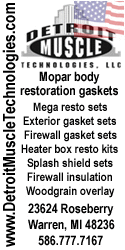You are using an out of date browser. It may not display this or other websites correctly.
You should upgrade or use an alternative browser.
You should upgrade or use an alternative browser.
Boxing in rear deck speakers ?
- Thread starter koosh
- Start date
j-c-c-62
Well-Known Member
That is a tough question. There are so many variables at play here. One issue is/was the speaker itself designed for a tuned cavity, most likely not.I’m installing new 6x9’s in 68 charger rear deck. Has anyone actually boxed these before hanging from rear deck, under the package tray?Wondering if much difference in sound quality?
I personally think in a typical car environment the effort/costs/time etc with proposed solution is not worth the small potential for any noticeable improvement. It could also degrade the sound quality and/or output.
It is a worthy question though.

Last edited:
BDnFL
Well-Known Member
I’m not a fan of the look from the trunk with speaker box’s hanging down. Personal preference, not trying to be rude.I’m installing new 6x9’s in 68 charger rear deck. Has anyone actually boxed these before hanging from rear deck, under the package tray?Wondering if much difference in sound quality?
I installed speakers in the package tray sound fine with the engine off !
Have you considered foam enclosures? Easy, economical, small in size.I’m not a fan of the look from the trunk with speaker box’s hanging down. Personal preference, not trying to be rude.
I installed speakers in the package tray sound fine with the engine off !
Mike
koosh
Well-Known Member
I have no idea what those are?Have you considered foam enclosures? Easy, economical, small in size.
Mike
koosh
Well-Known Member
Wont be seen when trunk is finishedI’m not a fan of the look from the trunk with speaker box’s hanging down. Personal preference, not trying to be rude.
I installed speakers in the package tray sound fine with the engine off !
YY1
Well-Known Member
Speaker specs should show ideal cabinet volume.
Although...
Lots of speakers designed for cars are designed to use the trunk volume as an enclosure, no matter the size.
A decent somewhat high wattage 6x9 probably needs a box about double the size of the "standard" 6x9 boxes you see that are just large enough to hold the speaker.
Although...
Lots of speakers designed for cars are designed to use the trunk volume as an enclosure, no matter the size.
A decent somewhat high wattage 6x9 probably needs a box about double the size of the "standard" 6x9 boxes you see that are just large enough to hold the speaker.
Rockland71GTX
Well-Known Member
This is a foam speaker enclosure. If you make a hard box to enclose the speakers you risk 'tuning' to a certain frequency that could ruin the sound quality. You can Google 'tuning a subwoofer box ' to get an idea of what I'm talking about.

I've run 6x9's in the rear deck with no additional box and the trunk itself does a good job of serving as the box. For mine I used high quality Jensen's rated at 200W and powered them with a 40W amp between the speakers and radio/CD player. It sounded killer and I got compliments all the time. For the amp, don't make the mistake of running a 200W amp with 200W speakers. You need the amp to be well below the rated max speaker handling and then everything will sound tight and nice. If you don't run any external amp at all and just rely on the radio/CD player built-in power, you probably won't notice much difference at all between boxed vs non-boxed speakers because you won't be giving the speakers the power they want.
whitechargernow
Member
Good answer. Made me think.I've run 6x9's in the rear deck with no additional box and the trunk itself does a good job of serving as the box. For mine I used high quality Jensen's rated at 200W and powered them with a 40W amp between the speakers and radio/CD player. It sounded killer and I got compliments all the time. For the amp, don't make the mistake of running a 200W amp with 200W speakers. You need the amp to be well below the rated max speaker handling and then everything will sound tight and nice. If you don't run any external amp at all and just rely on the radio/CD player built-in power, you probably won't notice much difference at all between boxed vs non-boxed speakers because you won't be giving the speakers the power they want.
j-c-c-62
Well-Known Member
That is misconstruing what is taking place. At some point any space when it becomes large enough relative to the speaker behind the speaker is effectively called an "infinite baffle". It is intended to provide no tuning, period. Nearly any size trunk meets that threshold with 6x9 speakers.Speaker specs should show ideal cabinet volume.
Although...
Lots of speakers designed for cars are designed to use the trunk volume as an enclosure, no matter the size.
A decent somewhat high wattage 6x9 probably needs a box about double the size of the "standard" 6x9 boxes you see that are just large enough to hold the speaker
As I mentioned earlier here, some speaker's performance is degraded with any cabinet mounting constraints. If a cabinet is a must, all the cabinet volumes chosen will affect the speakers performance differently and not always an improvement, if any. These are not recording studio monitors.
Last edited:
j-c-c-62
Well-Known Member
NOTHING could be further from the truth. I am not questioning your end results nor compliments received. Under powering any speaker is a recipe for distortion and often leads to speaker overload as fed signal goes square wave as the amp clips as volume is increased.I've run 6x9's in the rear deck with no additional box and the trunk itself does a good job of serving as the box. For mine I used high quality Jensen's rated at 200W and powered them with a 40W amp between the speakers and radio/CD player. It sounded killer and I got compliments all the time. For the amp, don't make the mistake of running a 200W amp with 200W speakers. You need the amp to be well below the rated max speaker handling and then everything will sound tight and nice. If you don't run any external amp at all and just rely on the radio/CD player built-in power, you probably won't notice much difference at all between boxed vs non-boxed speakers because you won't be giving the speakers the power they want.
Now if you are the main center of attention at car meets with your car's stereo and there is alcohol involved. a 40 watt amp feeding 200watt rated speakers might help you be able to listen to your stereo on the ride home, but that is like mounting a 2x4 under your gas pedal as a rev limiter.
and Speakers don't want any amount of power any more than a shock wants a bump.
j-c-c-62
Well-Known Member
A foam speaker enclosure has a tuning component, whether its beneficial to the case at hand is subjective and likely happenstance. There is likely no magic to the foam, other that its likely cheap and lightweight.This is a foam speaker enclosure. If you make a hard box to enclose the speakers you risk 'tuning' to a certain frequency that could ruin the sound quality. You can Google 'tuning a subwoofer box ' to get an idea of what I'm talking about.View attachment 1841443
YY1
Well-Known Member
That is misconstruing what is taking place. At some point any space when it becomes large enough relative to the speaker behind the speaker is effectively called an "infinite baffle". It is intended to provide no tuning, period. Nearly any size trunk meets that threshold with 6x9 speakers.
As I mentioned earlier here, some speaker's performance is degraded with any cabinet mounting constraints. If a cabinet is a must, all the cabinet volumes chosen will affect the speakers performance differently and not always an improvement, if any. These are not recording studio monitors.
...but nevertheless a true statement, just without the industry specific terminology.
j-c-c-62
Well-Known Member
Well then, we disagree, a true infinite baffle is not considered to be an "enclosure". Any enclosure can become when large enough an infinite baffle. There is no industry wide standard of exactly when that occurs other than when speaker mounting no longer effects "tuning", a rather imprecise point. In a car trunk application, any possible "tuning" will be affected by actual items in the trunk and their composition, A quick listen test under the right conditions can give some indication of possible trunk "tuning
by simply listening with trunk open or closed, but that is not a great test because that adds so many other variables.
Terminology counts.
by simply listening with trunk open or closed, but that is not a great test because that adds so many other variables.
Terminology counts.
thanks, but I partially disagree.NOTHING could be further from the truth. I am not questioning your end results nor compliments received. Under powering any speaker is a recipe for distortion and often leads to speaker overload as fed signal goes square wave as the amp clips as volume is increased.
Now if you are the main center of attention at car meets with your car's stereo and there is alcohol involved. a 40 watt amp feeding 200watt rated speakers might help you be able to listen to your stereo on the ride home, but that is like mounting a 2x4 under your gas pedal as a rev limiter.
and Speakers don't want any amount of power any more than a shock wants a bump.
It depends on the car stereo speakers and the external amp.
I forgot to say that the external amp I ran was a Concorde with a true 40W RMS, which put out a higher clean Watts than most of the 40W max amps at the time.
Before that I tried a 200W amp to power my 200W speaker and even at mid-volume those voice coils were launching so hard it was distortion city.
I did not have unlimited budget at the time, so perhaps a 100W amp would have been even better. What I do know is that using an external amp with the same total wattage rating as the speakers being used is a recipe for disaster. The same rule of thumb also applies to guitar amplifier wattage vs speaker ratings, which I'm very hands-on familiar with (i.e. no guitar combo amp manufacturers ever load their 15W combo cabs with a 15W speaker - it's always a 30W or 60W speaker - even if one wants guitar speaker musical distortion).
Turning up a car stereo over mid-volume with no external amp will damage the speakers quicker than if extra wattage under the limit is applied. That's what I meant by "what the speakers want". I speak from experience.
j-c-c-62
Well-Known Member
I do not doubt your experience. I do question the basis for your conclusion from it.thanks, but I partially disagree.
It depends on the car stereo speakers and the external amp.
I forgot to say that the external amp I ran was a Concorde with a true 40W RMS, which put out a higher clean Watts than most of the 40W max amps at the time.
Before that I tried a 200W amp to power my 200W speaker and even at mid-volume those voice coils were launching so hard it was distortion city.
I did not have unlimited budget at the time, so perhaps a 100W amp would have been even better. What I do know is that using an external amp with the same total wattage rating as the speakers being used is a recipe for disaster. The same rule of thumb also applies to guitar amplifier wattage vs speaker ratings, which I'm very hands-on familiar with (i.e. no guitar combo amp manufacturers ever load their 15W combo cabs with a 15W speaker - it's always a 30W or 60W speaker - even if one wants guitar speaker musical distortion).
Turning up a car stereo over mid-volume with no external amp will damage the speakers quicker than if extra wattage under the limit is applied. That's what I meant by "what the speakers want". I speak from experience.
Guitars and their speakers create music, car speakers are normally tasked with reproducing it, a huge difference.
The guitar amp analogy does not invalidate the details explained about the car stereo amp and speakers. I was only adding that extra example to further support understanding for others.I do not doubt your experience. I do question the basis for your conclusion from it.
Guitars and their speakers create music, car speakers are normally tasked with reproducing it, a huge difference.
In the end, it's up to the OP to sift through experiences presented by all of us and then make their own conclusions
j-c-c-62
Well-Known Member
Baloney, this detail (which was not explained) among others is flat out wrong, "You need the amp to be well below the rated max speaker handling and then everything will sound tight and nice."The guitar amp analogy does not invalidate the details explained about the car stereo amp and speakers. I was only adding that extra example to further support understanding for others.
In the end, it's up to the OP to sift through experiences presented by all of us and then make their own conclusions
Besides stating the obvious, "In the end, it's up to the OP to sift through experiences presented by all of us and then make their own conclusions", I submit it might be more advisable for the OP to weigh greater the advice of those with way more in-depth professional knowledge of the matter at hand then antidotal unscientific unsupported personal experiences to achieve the best solution.
Similar threads
- Locked
- Replies
- 0
- Views
- 370
- Replies
- 0
- Views
- 268
















